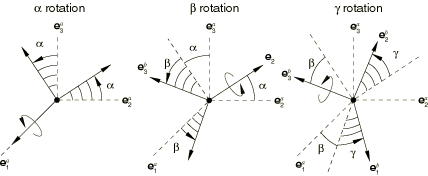CARDAN | |||||||||
|
| ||||||||
ProductsAbaqus/StandardAbaqus/ExplicitAbaqus/CAE
Description

The CARDAN connection does not impose kinematic constraints. A CARDAN connection is a finite rotation connection where the local directions at node b are parameterized in terms of Cardan (or Bryant) angles relative to the local directions at node a. Local directions are positioned relative to by three successive finite rotations , , and as follows:
Rotate by radians about axis ;
Rotate by radians about the intermediate 2-axis, ; and
Rotate by radians about axis .
Rotation angle should be moderate (magnitude less than ), whereas and may be arbitrarily large (i.e., magnitude greater than ). The Cardan angles are determined by the local directions as
Here, m and n are integers that account for rotations with a magnitude greater than .
The three available components of relative motion in the CARDAN connection are the changes in the Cardan angles positioning the local directions at node b relative to the local directions at node a. Therefore,
where , , and are the initial Cardan angles. The connector constitutive rotations are
The kinetic moment in a CARDAN connection is determined from the three component relationships:
![]()
Summary
| ||||||||||||||||||||||||||||